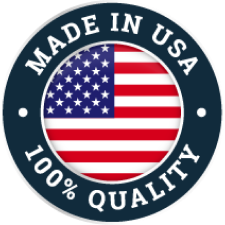
Just like any industry, the world of air filtration and purification has its own set of abbreviations, to sum up, a term or process. If you’re in the market for a quality air filtration and purification system, it’s important to understand the terminology so you can make an educated decision, without strictly relying on reviews.
HEPA – High-Efficiency Particulate Air
The U.S. Environmental Protection Agency (EPA) describes HEPA as a type of pleated mechanical air filter that can remove at least 99.97% of dust, pollen, mold, bacteria, and any airborne particles with a size of 0.3 microns (µm).
CFM – Cubic Feet per Minute
A common way to measure airflow, CFM is how many cubic feet can be moved or exchanged each minute. CFM helps determine which type of air purifier is needed to efficiently filter a specific area.
To learn more about CFM or to calculate CFM for your space, click here.
CADR – Clean Air Delivery Rate
An established standard defined by the Association of Home Appliance Manufacturers (AHAM), CADR measures the effectiveness of an air purifier based on room space and the volume of clean air produced per minute. Results show how well the three most common indoor air pollutants (dust, pollen, and smoke) are removed.
ACH – Air Changes per Hour
ACH determines how many times an air purifier can exchange the whole volumetric air from a specific area in an hour. To calculate ACH, you need the Clean Air Delivery Rate (CADR) of the air purifier in cubic feet per minute (CFM) and the dimensions of the area. Then apply the values to the following equation:
(CFM x 60) / (L x W x H)
VOCs – Volatile Organic Compounds
VOCs are emitted as gases from certain solids or liquids, including a variety of chemicals, some of which may have short-term and long-term health effects. According to the EPA, many VOCs are human-made chemicals with concentrations of airborne pollutants up to 10x higher indoors.
UV – Ultraviolet
Using short-wave ultraviolet light (UV-C), UV air purifiers can inactivate harmful airborne microorganisms such as bacteria, viruses, and mold. When a microorganism absorbs UV light, the light damages or destroys its DNA, which kills the microorganism or renders it harmless.
OSHA – Occupational Safety and Health Administration
Created by Congress in 1970, OSHA is part of the U.S Department of Labor. OSHA’s Mission is “to ensure safe and healthful working conditions for workers by setting and enforcing standards and by providing training, outreach, education and assistance .” To learn more about OSHA regulations regarding indoor air quality in the workplace, click here.
MERV – Minimum Efficiency Reporting Value
Developed by the American Society of Heating, Refrigeration and Air Conditioner Engineers (ASHRAE), MERV ratings range from 1 to 16 depending on how effectively a filter traps small particles. The higher the MERV rating, the better the filter is at trapping the smallest particles.
MatrixAir offers a variety of residential and commercial air filtration systems to adapt to any environment. To ensure you get the perfect purifier, based on your individual needs, call us at (603) 863-7553 or contact us now!
